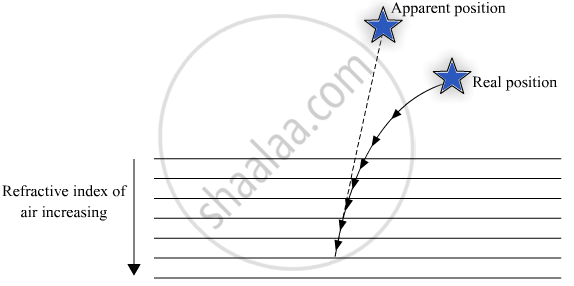Advertisements
Advertisements
प्रश्न
Explain in brief the reason for the following:
Twinkling of stars
What is the reason for twinkling of stars?
उत्तर १
Light coming from the stars undergoes refraction on entering the Earth’s atmosphere. This refraction continues until it reaches the Earth’s surface. This happens because of the temperature variation of atmospheric air. Hence, the atmospheric air has a changing refractive index at various altitudes. In this case, light from the stars continuously travels from a rarer medium to a denser medium. Hence, it continuously bends towards the normal.
The refractive index of air medium gradually increases with a decrease in altitude. The continuous bending of starlight towards the normal results in a slight rise in the apparent position of the star.
Since the physical conditions of the Earth’s atmosphere keep changing, the apparent position of the star is not stationary. The star changes its position continuously, which makes it twinkle. This happens because light from the stars travels a very large distance before reaching the observer. However, the path varies continuously because of uneven atmospheric conditions. Hence, the stars seem to be fluctuating, sometimes appearing bright and sometimes dull. All this, together, causes the twinkling of stars.
उत्तर २
The twinkling of stars is caused by atmospheric refraction of starlight. The starlight passes through different layers of the Earth's atmosphere, which have varying densities. This bending of light makes the stars appear to twinkle.
Notes
Students can refer to the provided solutions based on their preferred marks.
संबंधित प्रश्न
Which colour of the spectrum has
longest wavelength,
Name some everyday objects:
which absorb all the colours in sunlight
What happens when a beam of sunlight enters a dusty room through a window? Explain your answer.
Out of blue light and red light, which one is scattered more easily?
Sunset is red because at that time the light coming from the sun has to travel:
(a) lesser thickness of earth's atmosphere
(b) greater thickness of earth's atmosphere
(c) varying thickness of earth's atmosphere
(d) along the horizon
When sunlight enters the earth’s atmosphere, state which colour of light is scattered
- the most and
- which the least.
Answer the following question:
Why is the Tyndall effect shown by colloidal particles? State four instances of observing the Tyndall effect.
The clear sky appears blue because:
How can we explain the reddish appearance of sun at sunrise or sunset? Why does it not appear red at noon?
The colour of clear sky from the earth appears blue but from the space it appears black. Why?
